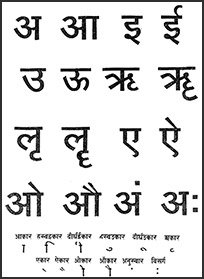Aksharasamamnaya, Akṣarasamāmnāya: 4 definitions
Introduction:
Aksharasamamnaya means something in Hinduism, Sanskrit. If you want to know the exact meaning, history, etymology or English translation of this term then check out the descriptions on this page. Add your comment or reference to a book if you want to contribute to this summary article.
The Sanskrit term Akṣarasamāmnāya can be transliterated into English as Aksarasamamnaya or Aksharasamamnaya, using the IAST transliteration scheme (?).
In Hinduism
Vyakarana (Sanskrit grammar)
Source: Wikisource: A dictionary of Sanskrit grammarAkṣarasamāmnāya (अक्षरसमाम्नाय).—Alphabet: traditional enumeration of phonetically independent letters generally beginning with the vowel a (अ). Although the number of letters and the order in which they are stated differ in different treatises, still, qualitatively they are much the same. The Śivasūtras, on which Pāṇini's grammar is based, enumerate 9 vowels, 4 semi-vowels, twenty five class-consonants and 4 | sibilants. The nine vowels are five simple vowels or monothongs (समा-नाक्षर (samā-nākṣara)) as they are called in ancient treatises, and the four diphthongs, (सन्ध्यक्षर (sandhyakṣara)). The four semi-vowels y, v, r, l, (य् व् र् ल् (y v r l)) or antasthāvarṇa, the twenty five class-consonants or mutes called sparśa, and the four ūṣman letters ś, ṣ, s and h (श् ष् स् ह् (ś ṣ s h)) are the same in all the Prātiśākhya and grammar works although in the Prātiśākhya works the semi-vowels are mentioned after the class consonants.The difference in numbers, as noticed, for example in the maximum number which reaches 65 in the Vājasaneyi-Prātiśākhya, is due to the separate mention of the long and protracted vowels as also to the inclusion of the Ayogavāha letters, and their number. The Ayogavāha letters are anusvāra, visarjanīya,jihvāmulīya, upadhmānīya, nāsikya, four yamas and svarabhaktī. The Ṛk Prātiśākhya does not mention l (लृ (lṛ)), but adding long ā (आ) i (ई) ,ū (ऊ) and ṛ (ऋ) to the short vowels, mentions 12 vowels, and mentioning 3 Ayogavāhas (< क् (k), = प् (p) and अं (aṃ)) lays down 48 letters. The Ṛk Tantra Prātiśākhya adds the vowel l (लृ (lṛ)) (short as also long) and mentions 14 vowels, 4 semivowels, 25 mutes, 4 sibilants and by adding 10 ayogavāhas viz. 4 yamas, nāsikya, visarjanīya, jihvāmulīya, upadhmānīya and two kinds of anusvāra, and thus brings the total number to 57. The Ṛk Tantra makes a separate enumeration by putting diphthongs first, long vowles afterwards and short vowels still afterwards, and puts semi-vowels first before mutes, for purposes of framing brief terms or pratyāhāras. This enumeration is called varṇopadeśa in contrast with the other one which is called varṇoddeśa. The Taittirīya prātiśākhya adds protracted vowels and lays down 60 letters : The Ṣikṣā of Pāṇini lays down 63 or 64 letters, while the Vājasaneyi-prātiśākhya gives 65 letters. cf. V. Pr. VIII. 1-25. The alphabet of the modern Indian Languages is based on the Varṇasamāmnāya given in the Vājasaneyi-prātiśākhya. The Prātiśākhyas call this enumeration by the name Varṇa-samāmnāya. The Ṛk tantra uses the terms Akṣara samāmnāya and Brahmarāśi which are picked up later on by Patañjali.cf. सोयमक्षरसमाम्नायो वाक्समाम्नायः पुष्पितः फलितश्चन्द्रतारकवत् प्रतिमण्डितो वेदि-तव्यो ब्रह्मराशिः । सर्ववेदपुण्यफलावाप्तिश्चास्य ज्ञाने भवति । मातापितरौ चास्य स्वर्गे लोके महीयेते । (soyamakṣarasamāmnāyo vāksamāmnāyaḥ puṣpitaḥ phalitaścandratārakavat pratimaṇḍito vedi-tavyo brahmarāśiḥ | sarvavedapuṇyaphalāvāptiścāsya jñāne bhavati | mātāpitarau cāsya svarge loke mahīyete |) M. Bh. Ahnika.2-end.

Vyakarana (व्याकरण, vyākaraṇa) refers to Sanskrit grammar and represents one of the six additional sciences (vedanga) to be studied along with the Vedas. Vyakarana concerns itself with the rules of Sanskrit grammar and linguistic analysis in order to establish the correct context of words and sentences.
Languages of India and abroad
Sanskrit dictionary
Source: Cologne Digital Sanskrit Dictionaries: Monier-Williams Sanskrit-English DictionaryAkṣarasamāmnāya (अक्षरसमाम्नाय):—[=a-kṣara-samāmnāya] [from a-kṣara] m. alphabet, [Patañjali; Bhāgavata-purāṇa]
[Sanskrit to German]
Sanskrit, also spelled संस्कृतम् (saṃskṛtam), is an ancient language of India commonly seen as the grandmother of the Indo-European language family (even English!). Closely allied with Prakrit and Pali, Sanskrit is more exhaustive in both grammar and terms and has the most extensive collection of literature in the world, greatly surpassing its sister-languages Greek and Latin.
See also (Relevant definitions)
Partial matches: Akshara, Samamnaya.
Full-text: Aksharasamamnayika, Samamnaya, Matrikavarna, Sancaya, Rashi, Brahmarashi.
Relevant text
Search found 3 books and stories containing Aksharasamamnaya, Akṣarasamāmnāya, Akshara-samamnaya, Akṣara-samāmnāya, Aksarasamamnaya, Aksara-samamnaya; (plurals include: Aksharasamamnayas, Akṣarasamāmnāyas, samamnayas, samāmnāyas, Aksarasamamnayas). You can also click to the full overview containing English textual excerpts. Below are direct links for the most relevant articles:
Brahma Sutras (Shankaracharya) (by George Thibaut)
I, 3, 10 < [First Adhyāya, Third Pāda]
Vakyapadiya of Bhartrihari (by K. A. Subramania Iyer)
Verse 1.11 < [Book 1 - Brahma-kāṇḍa (or Āgama-samuccaya)]
Vasudevavijaya of Vasudeva (Study) (by Sajitha. A)
Rāmavarmamahārājacaritra of Vaikkath Pāccu Mūttatu < [Chapter 1 - Śāstrakāvyas—A Brief Survey]